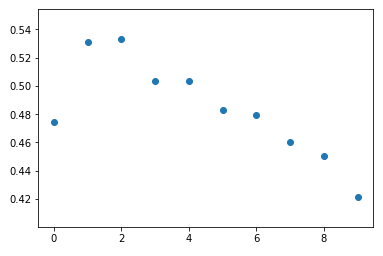I'm building a logistic regression model where yes is the target, one of the attributes spnr_avg_spend_mod is shown below. It is a continuous variable but has been binned up into 10 bins using pd.qcut.
As shown in the image below, apart from the first data point there is a linear decrease in the proportion of yes with increasing spend (increasing spnr_avg_spend_mod).
I am looking for ideas/methods on how to deal to this when modelling as it is a nice feature apart from that point.
In [14]: df
Out[25]:
spnr_avg_spend_mod yes
0 0 0.474293
1 1 0.531138
2 2 0.533260
3 3 0.503260
4 4 0.503418
5 5 0.482936
6 6 0.479729
7 7 0.460062
8 8 0.450755
9 9 0.421202
In [15]: plt.scatter(df.spnr_avg_spend_mod, df.yes)
Out[15]: <matplotlib.collections.PathCollection at 0x7f80962873c8>




yesatspnr_avg_spend_mod=0? One model would just draw a straight line between neighboring points. This would hit every point exactly, but the function would not be very smooth. Is this a valid way to "deal with" this problem? Why or why not? In other words, what problem are you trying to solve? $\endgroup$